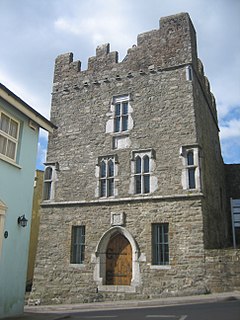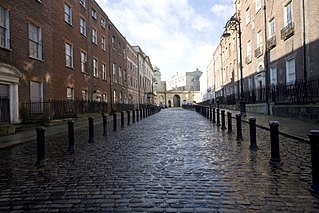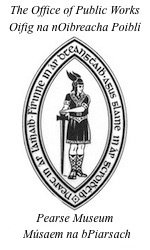 W
WThe An Post Museum or GPO Museum was located in the General Post Office in Dublin, Ireland opened on 28 July 2010. It closed on 30 May 2015 to make way for the new GPO: Witness History Interpretive Centre. It was a small museum which offered visitors an insight into the role played by the Post Office in the development of Irish society over many generations. The An Post Museum & Archive continues to hold the Post Office's heritage and philatelic collections, mount occasional temporary displays of its material and publish research on aspects of Irish Post Office history.
 W
WArigna, is a village in County Roscommon, Ireland. It is near Lough Allen, on a designated "scenic route" between Keadue and Sliabh an Iarainn. Arigna is situated in Kilronan Parish alongside the villages of Keadue and Ballyfarnon. The village lies close to the shores of Lough Allen. There is a long association with the coal mining industry, carried out for over 400 years until the mines closed in 1990.
 W
WThe Arklow Maritime Museum opened in 1976 in the old technical school on Saint Marys Road in Arklow, County Wicklow. Its original purpose was to celebrate the town's rich seafaring heritage, described by the late maritime historian John de Courcy Ireland in a letter to the museum as "Ireland's Most Maritime Town". In 2009, the museum moved to its current location at the Bridgewater Shopping Centre.
 W
WThe Cobh Heritage Centre is a museum located in Cobh, County Cork, Ireland. It is attached to Cobh railway station.
 W
WThe National Museum of Ireland – Country Life is located in Turlough village, 8 km (5.0 mi) northeast of Castlebar, County Mayo, Ireland. Established in 2001, the museum is part of the National Museum of Ireland and is the only national museum outside Dublin. The museum exhibits the way of life of rural Irish people between 1850 and 1950, and is in the grounds of Turlough Park House. There are displays about the home, the natural environment, trades and crafts, communities, and working on the land and water.
 W
WDesmond Castle is a tower house located in the town of Kinsale in County Cork, Ireland.
 W
WThe Dublin Writers Museum was opened in November 1991 at No 18, Parnell Square, Dublin, Ireland. The museum occupies an original 18th-century house, which accommodates the museum rooms, library, gallery, and administration area. The annexe behind it has a coffee shop and bookshop on the ground floor and exhibition and lecture rooms on the floors above. Dublin stuccadore Michael Stapleton decorated the upstairs gallery. The Irish Writers' Centre, next door in No 19, contains the meeting rooms and offices of the Irish Writers' Union, the Society of Irish Playwrights, the Irish Children's Book Trust and the Irish Translators' & Interpreters' Association. The basement beneath both houses is occupied by the Chapter One restaurant.
 W
WThe Dunbrody is a three-masted barque built in New Ross in 2001 by New Ross Drydock for the Dunbrody Project, with the financial assistance of the J. F. Kennedy Trust. The final fit-out including production of main deck, bulwark, deckhouse, interior, electrics and plumbing was done by the German company navcon.naval consulting GmbH. The ship was converted to a Lloyd's Register approved passenger sailing vessel in 2006 by the German company Neptun Peenemuende GmbH. For this two main engines, a bowthruster, watertight bulkheads and a modern navigation system were added. The ship sailed to England twice in the following years.
 W
WEPIC The Irish Emigration Museum is located in Dublin's Docklands which covers the history of the Irish diaspora and emigration to other countries. It was designed by the London-based design firm Event Communications and was voted as "Europe's Leading Tourist Attraction" at the 2019 World Travel Awards.
 W
WThe Garda Museum and Archives is a police museum located in Dublin, Ireland, located in the Treasury Building of Dublin Castle.
 W
WGlasnevin Cemetery is a large cemetery in Glasnevin, Dublin, Ireland which opened in 1832. It holds the graves and memorials of several notable figures, and has a museum.
 W
W14 Henrietta Street is a museum located on Henrietta Street in Dublin, Ireland. It opened in September 2018.
 W
WThe Sanctuary of Our Lady of Knock, usually named only as the Knock Shrine, is a Roman Catholic pilgrimage site and National Shrine in the village of Knock, County Mayo, Ireland, where observers stated that there was an apparition of the Blessed Virgin Mary, Saint Joseph, Saint John the Evangelist, angels, and Jesus Christ in 1879.
 W
WThe Little Museum of Dublin is a people's museum of Dublin, situated at 15 St. Stephens Green, Dublin, Ireland. The museum is located in an 18th-century Georgian town house owned by Dublin City Council.
 W
WMillmount is a large fortified complex situated on a great mound on the South bank of the River Boyne located in Drogheda, County Louth, Ireland. The fort has played a crucial part in Drogheda's history and has been a dominant feature from Norman settlement, to Cromwell's invasion to the more recent Civil War in 1922, in which the famous Martello tower was shelled and all but destroyed. Today the complex houses the Millmount Museum which houses a wide variety of artifacts of local and national importance. The complex is Drogheda's most dominant feature, clearly visible from all parts of the town. The Martello tower is affectionately known as "The Cup and Saucer" by locals. The whole fort is a national monument and has been designated as Drogheda's Cultural Quarter.
 W
WThe Museum of Literature Ireland (MoLI) is a literary museum in Dublin, Ireland. It opened in September 2019.
 W
WThe National Maritime Museum of Ireland opened in 1978 in the former Mariners' Church in Moran Park, located between the seafront and the centre of Dún Laoghaire town, southeast of Dublin city. President Michael D. Higgins officially re-opened the museum in 2012.
 W
WThe National Museum of Ireland is Ireland's leading museum institution, with a strong emphasis on national and some international archaeology, Irish history, Irish art, culture, and natural history. It has three branches in Dublin and one in County Mayo:National Museum of Ireland – Archaeology, Dublin National Museum of Ireland – Decorative Arts and History, Dublin National Museum of Ireland – Country Life, near Castlebar National Museum of Ireland – Natural History, Dublin
 W
WThe National Museum of Ireland – Archaeology is a branch of the National Museum of Ireland located on Kildare Street in Dublin, Ireland, and dealing with Irish and other antiquities. In general, the museum covers the history of Ireland from the Stone Age to the Late Middle Ages. Many important artefacts from the museum were featured in The Irish Times feature and book A History of Ireland in 100 Objects.
 W
WThe National Museum of Ireland - Decorative Arts & History is a branch of the National Museum of Ireland located at the former Collins Barracks in the Arbour Hill area of Dublin, Ireland.
 W
WThe National Transport Museum of Ireland is based in the grounds of Howth Castle in Ireland.
 W
WThe Pearse Museum is dedicated to the memory of Patrick Pearse and his brother, William. Patrick Pearse was an educationalist and nationalist who was executed for his part in the 1916 Rising. The museum is situated in the suburb of Rathfarnham on the south side of Dublin, Ireland. It was formerly an Irish speaking school named St. Enda's. Originally Pearse's school was set up in Ranelagh on 8 September 1908. It moved to Rathfarnham in 1910. After Pearse was executed for his part take in the 1916 rising, and due to decreasing numbers and increasing financial worries, the school closed in 1935. After Padraig Pearse's sister died in 1968, St. Enda's and its grounds were handed over to the state, and the school house is now a museum devoted to the Pearse brothers. The museum contains reconstructions of many of the original rooms, including Pearse's study, the family sitting room, the school art gallery, the school museum and one of the dormitories. There is also a gallery devoted exclusively to the sculpture of William Pearse. Visitors can also visit a nature study room in the courtyard behind the school house where examples of Irish plants and animals can be found.
 W
WYe Olde Hurdy Gurdy Museum of Vintage Radio is a museum of communication history based in the Martello tower in Howth, Dublin.